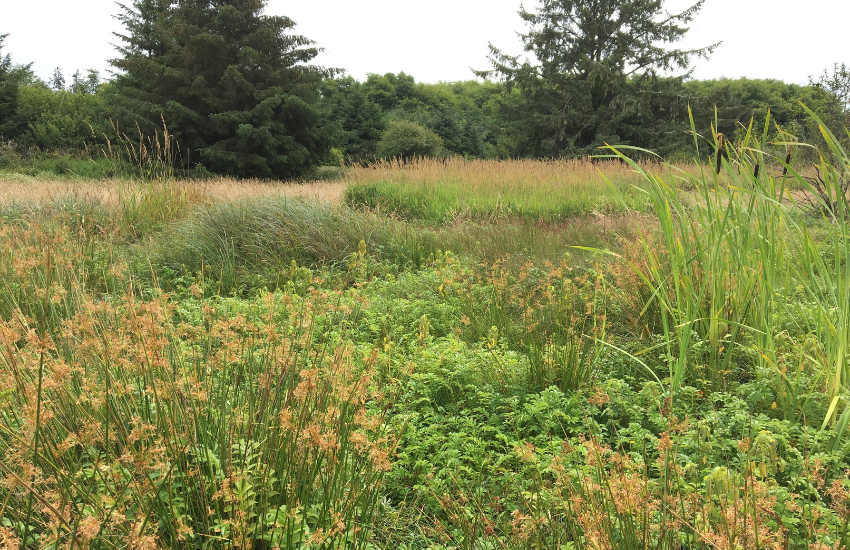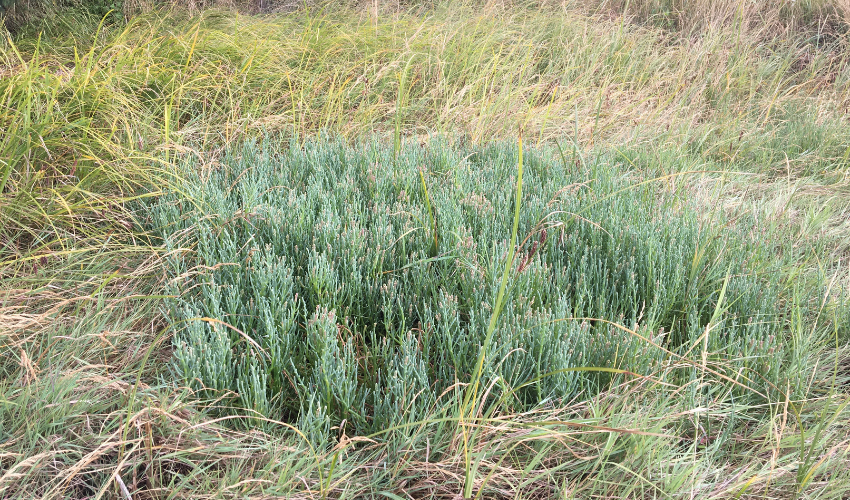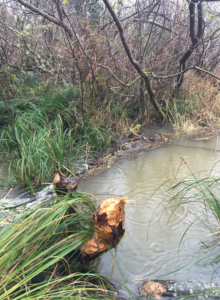Contributed by Volunteer Site Steward Jeff Roehm

Wahanna Marsh after 30 years of conservation.
A little more than a year ago, Stewardship Director Melissa Reich reminded me that I’d soon be starting my 10th summer as a volunteer Site Steward with North Coast Land Conservancy. This got me thinking (and writing) as I started looking back through my visits this past year. Actually writing about this, however, was really hard. I think there was just too much in my head and I couldn’t sort it out.
I was rescued by my daughter Karen, who gave me a little book she thought I should read. It was “A Sand County Almanac,” the landmark book by Aldo Leopold that was published posthumously after his untimely death, just days after he signed the forward on March 4, 1948. The book marked the first use of the term “land ethic” and sparked an environmental movement that eventually gave rise to what we are doing today at NCLC. The book, as the title suggests, is a simple diary of what Leopold saw and thought as he went through the year on his small farm in central Wisconsin.
As I read through the first chapters, I was flooded with visions of my own experiences out on the land. Most of my images were from Wahanna Marsh, a very special place and my first site-stewarding property. Then I came to the eighth chapter, titled “August, The Green Pasture.” The chapter was just two pages, all about a marsh plant that Leopold called eleocharis, about how this beautiful plant was “a sign the river was in a painting mood.” He wrote, “The deer walk up and down in it, apparently just for the pleasure of feeling it underfoot.”
With the image of this beautiful sedge, Aldo Leopold reached out to me through 74 years of time and space, and into the center of Wahanna Marsh. It was time to celebrate.
June 15, 2021
It wasn’t quite yet summer on this day last June as I headed out onto Wahanna Marsh to begin my 10th summer, but close enough. According to my records, this would be my 67th visit, which is a little bit more than the accreditation standard of one visit annually.
It was back on June 12, 2012, almost exactly nine years earlier, that Celeste Coulter (now Lebo), NCLC’s then-Stewardship Director, took me out here for an orientation as one of NCLC’s first site stewards. I later found out that Wahanna Marsh was also NCLC’s first property, having been donated in 1991 by Seaside Kids Inc., the softball people from across the street.
This little 5.7-acre parcel was part of a wetland mitigation to make possible two softball fields and a parking lot on what had once been a dairy farm. The farm, of course, had been created back in the early 20th century by ditching and draining a wetland. What goes around comes around… at least in this case.
In earlier days when I was growing up in Seaside, this was way out in the country. The bridge on East Broadway over Neawanna Creek wasn’t completed until I was a sophomore in high school, and the road from 12th street down through Bear Valley didn’t come this far. Earlier yet, there had been a makeshift bridge right here on the north border of this property, over what was then called Wahanna Creek, connecting these farms to Finntown over on the west side near present-day Avenue H. That bridge was long gone once cars and trucks took over the roads. Today we’re actually within the Seaside city limits, surrounded by a hospital, schools and homes. This is now nature’s gift to Seaside, a little piece of solitude in the city, and some space for the plants and animals that are here too.
So this was my assignment, watching over an old cow pasture with some ponds dug along one side, with plenty of time to wait for it to naturally become what it always was meant to be: A fully functioning tidal saltmarsh. It seemed pretty marshy out here already, but then about six years ago, the beavers moved in. With them came amazing changes. As they say, “Life follows water.” What they don’t say is that watching it happen, from season to season and year to year, is an almost magical experience. This is exactly what site stewards get to do.
In mid-June, walking out here used to be “boots optional.” Not so now, as the entry starts with a wade through a system of beaver ponds that’s also filled with flooded Hooker’s willows. This beginning gauntlet effectively keeps everyone out of here, except I’ve somehow figured out where to step, when to duck, and what to grab in order to steward the land.
Today there are some goals I’ve made that are designed to keep me from just wandering around accomplishing nothing. Number one is to bust a patch of Scotch broom over on the northwest corner. I’d actually spotted it on an aerial photo I saw on my computer that was taken a few days earlier. If you can see yellow flowers on an aerial photo of Seaside, it might be time to cut down that Scotch broom, or at least get started.
My goal lately has been to do a little “enhancement” on each visit. That’s NCLC speak for pulling weeds and busting broom. The idea is to keep things under control so a full work party is never necessary.
But first, I decided to check that big crabapple I rescued from a mass of ivy some years ago; not an easy task since it’s in the center of a huge patch of wild roses. I don’t really need to check it, but it’s right here next to the beaver pond. It’s close, and I just don’t trust those beavers. So out come the clippers, making sure not to cut the native plants, and in I go.

After about two hours, the upshot was that the tree was fine, with no ivy or tooth marks, and I made a good start on the Scotch broom as well. It was time to head out to our photo point in the center of the marsh, that old crabapple tree I’d nicknamed Methuselah.
June is still a little early out here. Marsh plants are mostly large, vigorous growers, but it takes them a while to get started after a long, wet, mucky winter; but there’s always something. In June it’s the red-winged blackbirds nesting down in the rushes that guard the edge of the large pond. The males fly around and rest up in that old crabapple, while the females are much harder to see. In the first place, they’re neither black nor red-winged, which keeps them hidden. Meanwhile, the males will dive at you the minute you wander too close to the nest.
Then just as I was turning to leave, I heard a racket down at the far bank of the pond. Suddenly out flew a huge bald eagle, crossing the pond and flying out over the open marsh. It was being chased by two very brave crows as it landed on a power pole that was over by that Scotch broom. The crows kept at it until that eagle finally gave up and flew off. Who knows what was going on, but my guess is that the crows had a nest of their own. When you’re up close and thinking blackbird, a bald eagle is startlingly big!
Summertime, Summertime, Sum-sum-summertime
It turns out that I ended up making five visits to Wahanna Marsh over the summer of 2021. How does this happen? Well, in a nutshell, there’s a study I’ve been doing where I’m trying to learn how to control a new plant in the marsh called spotted jewelweed. It’s a long story worthy of its own essay perhaps. Then there’s the European honeysuckle that keeps popping up, a vestige of the old farm. And finally there’s the matter of a small houseless camp on the east bank of the pond next to the road. It’s very neat and tidy but still there, on our land, keeping our nocturnal beavers on edge.
Since this was my 10th summer out here, I was thinking about the passage of time, and especially those first few years. I remember when I first learned about reed canarygrass, a very tall, sturdy grass that’s common in our moist meadows and wetlands. It was most likely planted here to make hay for the milk cows and is now the only invasive non-native plant in this open marsh. It’s described as “in patches along the east border” in the only historic written materials I have.
After learning what it was, I began seeing it everywhere and worried, “Is this stuff spreading? There seems to be so much of it.” Then it came to me; the advantage of being a site steward is time. I’m not going anywhere. So I found some stakes, attached some hot pink plastic tape, and put them in the ground on the perimeter of two nice patches. Then I simply watched and waited… for three years!

Almost immediately I stopped fretting. In the first place, just doing something, anything, helps. But also, I very quickly saw that the native plants wanted to be here too. Those patches of hay weren’t going anywhere. If anything, they were getting smaller or maybe even inching along slowly en masse in the direction that the grass fell each winter… heading north by northeast toward the beaver ponds where they would either drown or be eaten by the beavers.
This must be the way it is for all of our site stewards. That is, as you get to know a property, you settle into a routine and start to focus on careful observation and continuity. Our task is simply to look closely at nature, both positive and negative, and report and document what we see. This seems unstructured, but over time it’s the visits themselves that provide the structure. Without this discipline, an organization might get lucky, but most likely, we’d miss out on those unexpected things, learn little and find ourselves without a record when we really need it.
There are now 17 site stewards looking over 35 properties that cover at least 2,500 acres of NCLC-owned land. Some sites get the minimum three visits, which is still way more than the one annual visit required by accreditation. Some site stewards do more, including removing invasive plants and hosting their own work parties. There’s a site steward that visits six properties within a conservation unit, two who photo-monitor 14 locations on a single property. This is quite a group, with people waiting for COVID to lift so they can go through training and be added to the mix.
I think it’s clear from these numbers that this volunteer stewardship program allows NCLC to conserve more land. However, it also greatly improves the quality of stewardship simply by increasing the level of attention and care that the land receives.

A pickleweed (Salicorda pacifica) surprise
September 15, 2021
Late summer is my very favorite time to be out here. The plants have finally taken over the marsh, and if you’re lucky, there’ll be a flock of cedar waxwings in that old crabapple, which still produces plenty of fruit.
Today I went to the northwest corner to finish off that scotch broom, which I almost but not quite did. That’s okay, since I’ll finish it next time. While I was there I checked a little cove in the estuary that was part of the original mitigation design back in 1991. It was put there to give the marsh “low saltmarsh characteristics,” that is an area that is saltier. I’ll spare the details of how this was done, except to say that it’s been 30 years. Now, right in the center of this area is a very large colony of a plant called pickleweed (Salicorda pacifica), a salt-tolerant indicator plant that only grows in the saltier areas out near the bay. And apparently right here, just like the plan says. I took a photo just to show to Neal Maine, NCLC’s founding executive director and one of the designers of this little niche.
 As I’ve said, our beavers have helped bring lots of natural change out here. It’s not just the water, which is now always higher. The beavers do lots of digging and scraping. They make trails in the wet ground that turn into ruts and then become holes. Now the pond is much deeper and the sink holes more sunk, larger, more numerous and filled with new plants. In a word, the marsh now has more structure. Have these plants always been here? Maybe I just naturally started to notice them as I learned about them? I think not. Native plants are the experts of the universe at being able to find their way to the perfect place that is their niche in our amazing natural world. We didn’t do this. After a gentle kick-start, it all happened on its own, using forces beyond our grasp.
As I’ve said, our beavers have helped bring lots of natural change out here. It’s not just the water, which is now always higher. The beavers do lots of digging and scraping. They make trails in the wet ground that turn into ruts and then become holes. Now the pond is much deeper and the sink holes more sunk, larger, more numerous and filled with new plants. In a word, the marsh now has more structure. Have these plants always been here? Maybe I just naturally started to notice them as I learned about them? I think not. Native plants are the experts of the universe at being able to find their way to the perfect place that is their niche in our amazing natural world. We didn’t do this. After a gentle kick-start, it all happened on its own, using forces beyond our grasp.
After just a few minutes at the northwest property corner, I just walked out to the center of the marsh and looked around. Over the past 10 years, I’ve always finished my visits in the same spot, just east of Methuselah, on the bank of the large pond. From here you see no roadways, houses or power poles; just a pond in a completely natural setting. It’s a perfect place to mark the seasons and years as they pass by.
Our pond is dry now, probably for just a week or two before the fall rains fill it back up. A beautiful, lush, bright-green sedge carpets the pond bed. It’s feathery, almost mesmerizing to look at; a plant that grows in shallow water, but also needs a short dry spell. Our pond is the perfect niche. We call this plant common spikerush, its scientific name Eleocharis palustris. This sedge is one of just a few plants on planet Earth that has found a way to amp up photosynthesis so that it can grow super-fast when it gets the chance, like between shallow and dry, pond-time. It’s very common here on the Oregon North Coast, but it’s out in the marsh, in vernal freshwater pools, and overlooked by everyone.
So here’s the connection. This is the eleocharis of Aldo Leopold’s “A Sand County Almanac,” Chapter 8. It is so incredibly beautiful. If you want to feel the power of the “land ethic,” come and find your pond. It’s time to paint.

September on the Marsh: A Carpet of Eleocharis
Comments